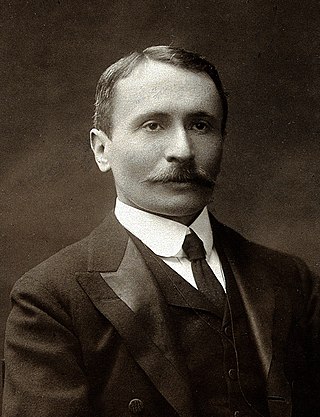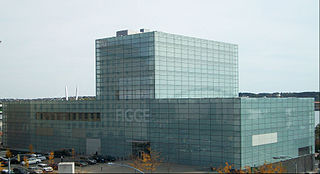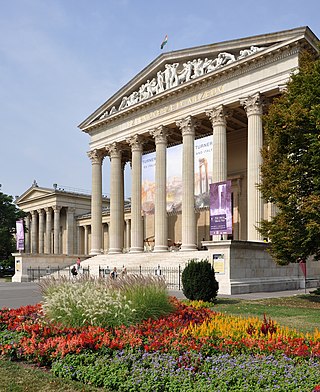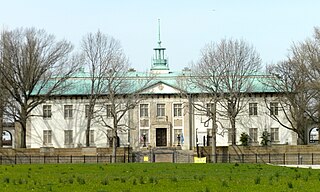Related Research Articles

Sir Marc Aurel Stein, (Hungarian: Stein Márk Aurél; 26 November 1862 – 26 October 1943) was a Hungarian-born British archaeologist, primarily known for his explorations and archaeological discoveries in Central Asia. He was also a professor at Indian universities.

Thomas Gainsborough was an English portrait and landscape painter, draughtsman, and printmaker. Along with his rival Sir Joshua Reynolds, he is considered one of the most important British artists of the second half of the 18th century. He painted quickly, and the works of his maturity are characterised by a light palette and easy strokes. Despite being a prolific portrait painter, Gainsborough gained greater satisfaction from his landscapes. He is credited as the originator of the 18th-century British landscape school. Gainsborough was a founding member of the Royal Academy.

The Lewis chessmen or Uig chessmen, named after the island or the bay where they were found, are a group of distinctive 12th-century chess pieces, along with other game pieces, most of which are carved from walrus ivory. Discovered in 1831 on Lewis in the Outer Hebrides of Scotland, they may constitute some of the few complete, surviving medieval chess sets, although it is not clear if a set as originally made can be assembled from the pieces. When found, the hoard contained 93 artifacts: 78 chess pieces, 14 tablemen and one belt buckle. Today, 82 pieces are owned and usually exhibited by the British Museum in London, and the remaining 11 are at the National Museum of Scotland in Edinburgh.
John Walker is an English painter and printmaker. He has been called "one of the standout abstract painters of the last 50 years."

The Percival David Foundation of Chinese Art holds a collection of Chinese ceramics and related items assembled by Percival David that are on permanent display in a dedicated gallery in Room 95 at the British Museum. The Foundation's main purpose is to promote the study and teaching of Chinese art and culture. The collection consists of some 1,700 pieces, mostly of Song, Yuan, Ming and Qing dynasty porcelain from the 10th century to the 18th. It includes a painting, Scroll of Antiquities.

Sir Michael Craig-Martin is an Irish-born contemporary conceptual artist and painter. He is known for fostering and adopting the Young British Artists, many of whom he taught, and for his conceptual artwork, An Oak Tree. He is Emeritus Professor of Fine Art at Goldsmiths. His memoir and advice for the aspiring artist, On Being An Artist, was published by London-based publisher Art / Books in April 2015.

The Figge Art Museum is an art museum in Davenport, Iowa. The Figge, as it is commonly known, has an encyclopedic collection and serves as the major art museum for the eastern Iowa and western Illinois region. The Figge works closely with several regional universities and colleges as an art resource and collections hub for a number of higher education programs.

The Yale Center for British Art at Yale University in central New Haven, Connecticut, houses the largest and most comprehensive collection of British art outside the United Kingdom. The collection of paintings, sculpture, drawings, prints, rare books, and manuscripts reflects the development of British art and culture from the Elizabethan period onward.

The Museum of Fine Arts is a museum in Heroes' Square, Budapest, Hungary, facing the Palace of Art.

Museo de Arte de Ponce (MAP) is an art museum located on Avenida Las Américas in Ponce, Puerto Rico. It houses a collection of European art, as well as works by Puerto Rican artists. The museum contains one of the most important Pre-Raphaelite collections in the Western Hemisphere, holding some 4,500 pieces of art distributed among fourteen galleries.
George Hewitt Myers was an American forester and philanthropist.

The American Swedish Historical Museum is the oldest Swedish-American museum in the United States. It is located in Franklin Delano Roosevelt Park in South Philadelphia, on part of a historic 17th-century land grant originally provided by Queen Christina of Sweden to settlers of New Sweden.

Spaces with Iron is a public sculpture by American artist Will Horwitt. It was installed in January 2009 on the Indiana University-Purdue University Indianapolis (IUPUI) campus, near downtown Indianapolis, Indiana. The sculpture is located at the corner of Blackford and Vermont Streets, on the southeast lawn of the Science Building, and is on long-term loan from the Indianapolis Museum of Art.

Thomas Hearne was an English landscape painter, engraver and illustrator. Hearne's watercolours were typified by applying a wash of subtle subdued colours over a clear outline in fine brush, pen or pencil. His techniques were studied by younger artists such as Thomas Girtin and J. M. W. Turner.

Jeremiah Dummer was the first American-born silversmith, whose works are today highly valued, two items of his having sold in 2004 and 2007 both for $204,000. He was also noted as a portrait painter and as an engraver, who created the first paper currency in Connecticut Colony. His son Jeremiah Jr. was involved with the foundation of Yale University.

The Nimrud ivories are a large group of small carved ivory plaques and figures dating from the 9th to the 7th centuries BC that were excavated from the Assyrian city of Nimrud during the 19th and 20th centuries. The ivories mostly originated outside Mesopotamia and are thought to have been made in the Levant and Egypt, and have frequently been attributed to the Phoenicians due to a number of the ivories containing Phoenician inscriptions. They are foundational artefacts in the study of Phoenician art, together with the Phoenician metal bowls, which were discovered at the same time but identified as Phoenician a few years earlier. However, both the bowls and the ivories pose a significant challenge as no examples of either – or any other artefacts with equivalent features – have been found in Phoenicia or other major colonies.
Pratapaditya Pal is an Indian scholar of Southeast Asian and Himalayan art and culture, specializing particularly in the history of art of India, Nepal and Tibet. He has served as a curator of South Asian art at several prominent US museums including Boston's Museum of Fine Arts, the Los Angeles County Museum of Art, and the Art Institute of Chicago, where he has organized more than 22 major exhibitions and helped build the museums' collection. He has also written over 60 books and catalogs, and over 250 articles on the subject, taught at several universities, and served as the editor of the Indian art magazine, Marg. In 2009 he was awarded Padma Shri by the Government of India for his contributions to the study of Indian art.
The Houdini Museum of New York is a museum exhibiting memorabilia related to the escape artist, Harry Houdini. It is located at Fantasma Magic, a retail magic manufacturer.
References
- ↑ "Prints and Printing Photograph Collection". Visual Resources Collection, Yale University Library. Retrieved 2011-10-23.
- ↑ "Első Magyar Festményszakértő Iroda - Nyitólap". Biralat.hu. Retrieved 2011-10-23.
- The British Museum.
{[stub}}